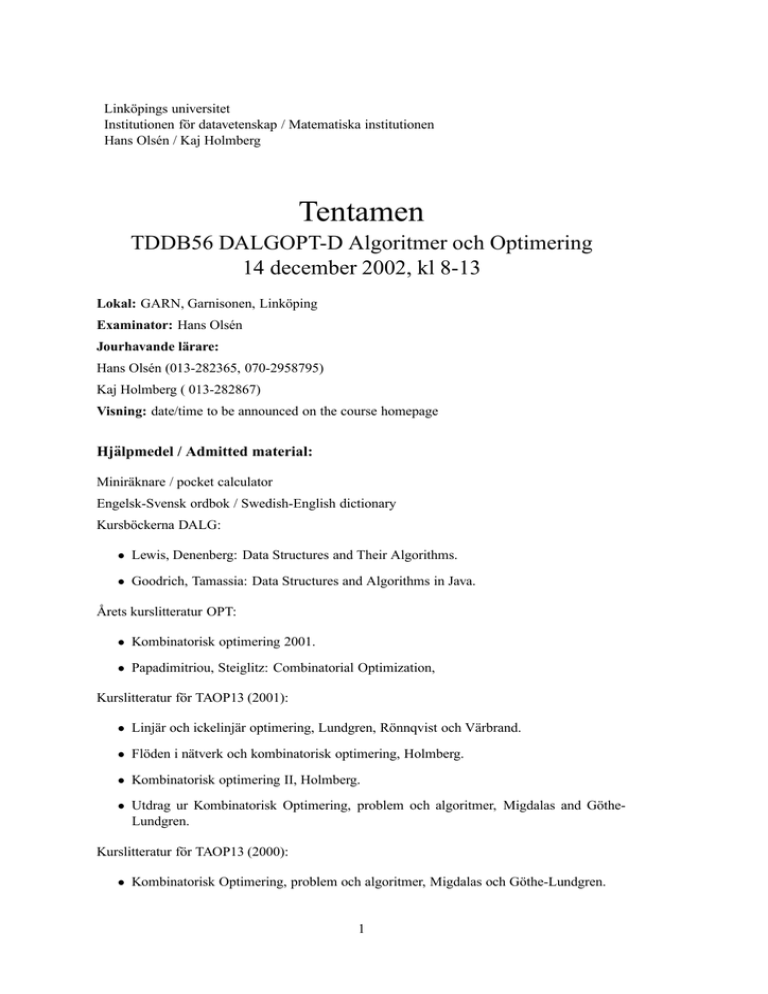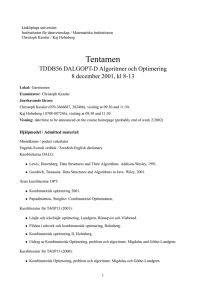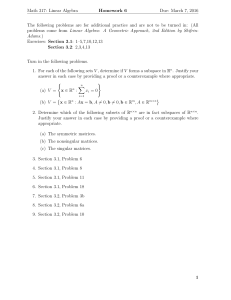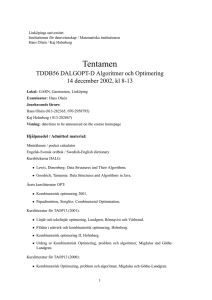Link¨opings universitet Institutionen f¨or datavetenskap / Matematiska institutionen
advertisement

Linköpings universitet
Institutionen för datavetenskap / Matematiska institutionen
Hans Olsén / Kaj Holmberg
Tentamen
TDDB56 DALGOPT-D Algoritmer och Optimering
14 december 2002, kl 8-13
Lokal: GARN, Garnisonen, Linköping
Examinator: Hans Olsén
Jourhavande lärare:
Hans Olsén (013-282365, 070-2958795)
Kaj Holmberg ( 013-282867)
Visning: date/time to be announced on the course homepage
Hjälpmedel / Admitted material:
Miniräknare / pocket calculator
Engelsk-Svensk ordbok / Swedish-English dictionary
Kursböckerna DALG:
• Lewis, Denenberg: Data Structures and Their Algorithms.
• Goodrich, Tamassia: Data Structures and Algorithms in Java.
Årets kurslitteratur OPT:
• Kombinatorisk optimering 2001.
• Papadimitriou, Steiglitz: Combinatorial Optimization,
Kurslitteratur för TAOP13 (2001):
• Linjär och ickelinjär optimering, Lundgren, Rönnqvist och Värbrand.
• Flöden i nätverk och kombinatorisk optimering, Holmberg.
• Kombinatorisk optimering II, Holmberg.
• Utdrag ur Kombinatorisk Optimering, problem och algoritmer, Migdalas and GötheLundgren.
Kurslitteratur för TAOP13 (2000):
• Kombinatorisk Optimering, problem och algoritmer, Migdalas och Göthe-Lundgren.
1
General instructions
• This exam has 9 assignments and 6 pages in total. Read all assignments carefully and
completely before you begin.
• Use a separate sheet for each assignment. Mark each sheet on top with your name,
personnummer, and the course code (TDDB56).
• You may answer in either English or Swedish.
• Write clearly. Unreadable text will be ignored.
• Be precise in your statements. Unprecise formulations may lead to a reduction of points.
• Motivate clearly all statements and reasoning.
• Explain calculations and solution procedures.
• The assignments are not ordered according to difficulty.
• If you use some result from the admitted literature that has not been part of the lectures,
give a reference (book title, page) or give an explanation.
• One copy of each of the admitted course books Lewis/Denenberg and Goodrich/Tamassia
is available for inspection at the central tentavakt desk. Please don’t remove them from
there.
1. (3p) Which of the following statements are true and which are false? Justify your answers. Answer without justification gives no credits.
(0.5p) a) n2 ∈ O(2n )
(0.5p) b) n log n ∈ Θ(n)
√
(0.5p) c) n ∈ Ω(log n)
(0.5p) d) O(n log n) ⊆ O(n2 )
(0.5p) e) Ω(n) ⊆ Θ(n2 )
(0.5p) f) Θ(n) ⊆ Ω(log n)
2
2. (7p) Consider the following LP-problem
max z = 6x1 + 3x2 + 5x3
subject to
3x1 + x2 − 2x3 ≤ 3
2x1 + 2x2 + x3 ≤ 6
x1 ,
x2 ,
x3 ≥ 0
(3p) a) Formulate the LP-dual to the problem above. Solve the dual graphically. Find
primal optimal solution with the help of the complementarity conditions.
(1p) b) Which primal variables are in the optimal basis? Give the basis matrix B.
(1p) c) Give the reduced costs for x1 , x2 and x3 at the optimal point.
(2p) d) Start from the origin and do one iteration with the simplex method (in the primal).
Which point is obtained? Is it optimal?
3. (3p) Let the set S = {4, 5, 9, 14, 23, 42, 49, 63} be given.
(1p) a) Construct a heap storing the elements of S (such that the minimum element appears
at the root): Draw the tree and the array representation.
(1p) b) Show the corresponding picture after performing a removeMin operation.
(1p) c) Show the corresponding picture after performing an insertItem operation with key
k=3 in the original heap.
4. (6p)
(1p) a) How shall a shortest path method (Ford’s or Dijkstra’s) be modified if the graph is
undirected? Do the modifications in the algorithm, not in the graph. (We should
assume that cij ≥ 0 ∀i, j. Why?)
(2p) b) Find the shortest path from node 1 to node 6 in the undirected graph below.
2
3
1
4
3
10
4
2
6
7
4
1
4
6
2
7
7
5
(Alternative for those who can’t do a: Make the graph directed (from left to right)
and solve. This gives max 1p.)
(1p) c) The arc costs satisfy the triangle inequality if c ij ≤ cik + ckj ∀k, i, j. This means
that the direct arc between node i and node j (which must exist) never is more
expensive than going via another node k.
Describe what happens if you try to solve a shortest path problem with Ford’s
method in an undirected graph where the arc costs satisfy the triangle inequality.
What do you know about the optimal solution?
(2p) d) Is it possible to correctly solve an undirected shortest path problem by finding the
minimal spanning tree and then removing all arcs that does not lie on the path
between the starting and ending nodes? Motivate the answer.
3
5. (7p) Recall that multiplication of two matrices, X and Y , of dimensions p × q and q × r
respectively (no. of rows × no. of columns), results in a matrix Z = XY of dimensions
p × r. You are given the program MultiplyMatrices(X,Y ) which computes the
product of X and Y requiring pqr scalar multiplications (“skalärmultiplikationer”). That
is, the time complexity is O(pqr). Matrix multiplication is not commutative, but it is
associative, which means that ABC = (AB)C = A(BC). The product ABC can thus
be evaluated either as MultiplyMatrices(MultiplyMatrices(A,B),C) or
as MultiplyMatrices(A,MultiplyMatrices(B,C)).
(2p) a) Suppose you are given the task to compute the product M = ABCD of the four
matrices A, B, C and D with the dimensions 50 × 10, 10 × 40, 40 × 30 and
30 × 5 respectively. In how many different ways can M be evaluated? Which order
of evaluating M is the best in terms of the total number of scalar multiplications
required for evaluating M , using the program above? (justify your answer)
(1p) b) Is the order you found in (5.a) always the best one, regardless of the dimensions of
the matrices? (justify your answer)
(4p) c) Consider the general problem of finding the best order in which to evaluate the
product A0 A1 · · · An for any sequence of matrices A0 , A1 , . . . , An . Assume that
the sequence is represented as an array of links to the matrices illustrated in the
figure below.
Construct an algorithm, FindMin(Lef t,Right), where the arguments Lef t and
Right are indices as illustrated, and which computes the number of scalar multiplications required for evaluating the product A Lef t ALef t+1 · · · ARight−1 ARight in
the best possible order. The algorithm need not return the actual order itself.
You have access to a procedure Complexity(L X ,RX ,LY ,RY ) taking four
arguments which are indices to the array, such that L X < RX and LY < RY (otherwise it returns NULL). Complexity(L X ,RX ,LY ,RY ) returns the number
of scalar multiplications required to evaluate the product Z = XY of the two matrices X and Y where X = ALX ALX +1 · · · ARX −1 ARX and Y = ALY ALY +1 · · ·
ARY −1 ARY . (It is implemented simply so as to compute the value pqr, where p
is the number of rows in ALX , q is the number of columns in ARX and r is the
number of columns in ARY . It also executes a test to verify that the number of
columns in ARX equals the number of rows in ALY . Otherwise the matrix product
is not defined, and in this case Complexity returns NULL.)
Hint: Use divide-and-conquer.
4
6. (4p) In the Steiner tree problem in an undirected graph G = (N, B) one shall find the
minimal (cheapest) tree that spans the nodes in N 0 , where N 0 ⊂ N . The tree must
contain all nodes in N 0 , but may also contain nodes in N \ N 0 if this decreases the cost.
(2p) a) Describe a heuristic that starts with finding a minimal spanning tree with a standard
method, and then tries to improve the solution. (Hint: There are similarities with
certain heuristics for the traveling salesman problem) Make sure that method is
polynomial and show it.
(2p) b) Apply the heuristic to the example below, where N 0 = {1, 3, 4}.
The cost for the obtained solution in this example must be at least 2 units lower
than the cost for the minimal spanning tree.
2
6
3
4
2
1
5
3
5
6
4
1
8
7
4
5
5
7. (4p)
(1.5p) a) Insert the numbers 3, 36, 7, 12, 13, 4, 23, 9, 22 (in this order) in a hash table of size
10, using open addressing with linear probing and the hash function h(k) = k mod
10.
(0.5p) b) How many probe operations are now required for findElement(22)?
(1p) c) Explain what is meant by ’load factor’ and its relation to the (expected) running
time of dictionary operations. Explain what is meant by ’rehashing’.
(1p) d) For open addressing, the operation removeElement can be a bit complicated. Why?
Describe a common way to approach this, and how it affects the dictionary operations findElement and insertItem.
5
8. (3p) Consider the directed network given by the following table. For each are (row) i is
the starting node, j the ending node, c ij tha arc cost, uij the capacity and xij the flow.
(All lower bounds are zero.)
i
1
1
2
2
3
4
4
5
j
2
3
3
4
5
3
5
2
cij
3
5
3
5
3
1
3
1
uij
4
10
5
10
5
3
4
3
xij
2
5
0
2
5
0
2
0
Find the maximal flow from node 1 to node 5. Start from the flow given above. Give
minimum cut. Give the complexity for the method used.
9. (3p) Given the following binary search tree:
(0.5p) a) Is this tree a proper binary tree? (justify your answer)
(0.5p) b) Is this tree a complete binary tree? (justify your answer)
(0.5p) c) Is this tree an AVL tree? (justify your answer)
(0.5p) d) Is the subtree with root 35 an AVL tree? (justify your answer)
(0.5p) e) Give the sequences of keys resulting from a preorder, inorder and postorder traversal of the tree.
(0.5p) f) Show the tree resulting from a (single) left rotation at the root node. Is the resulting
tree an AVL tree? (justify your answer)
6





